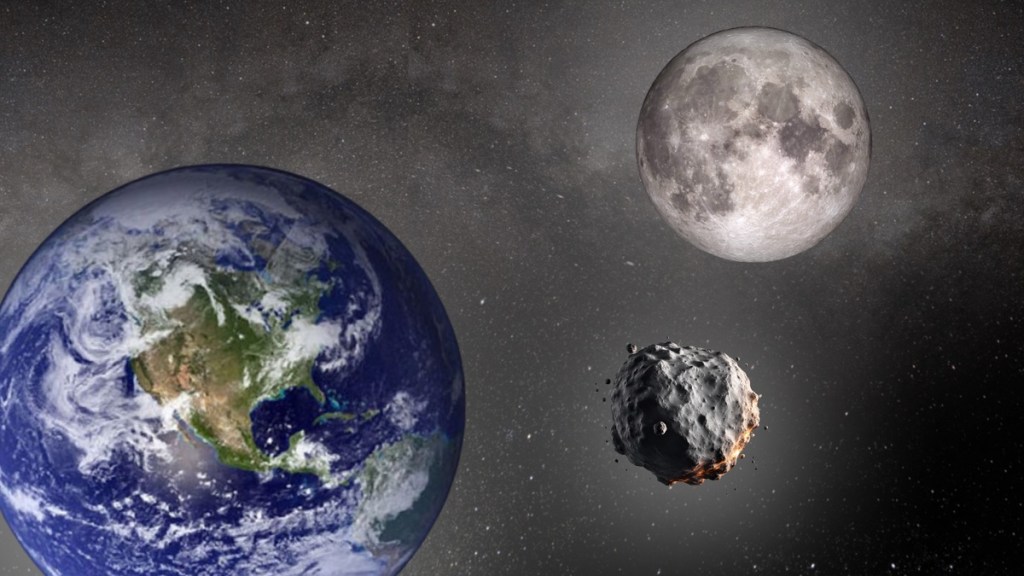OUR SPACE: Earth’s second moon
Published 8:03 am Monday, December 9, 2024

- An illustration of the asteroid 2024 PT5 as it leaves Earth after a stint as our ‘second moon.’ (Robert Lea for Space.com)
Everybody knows Earth has only one moon. And while there are hundreds of moons populating our solar system (most of them keeping the giant outer gas planets company), and they all have fancy names with a common theme, Earth’s moon is creatively named — Moon. But hey, at least we have one — the inner planets Mercury and Venus trudge along their orbits all by their lonesome…
But every once in a while, Earth gets another moon. They are usually temporary — asteroids that orbit the sun in the Arjuna asteroid belt (which is very close to Earth but is way less famous than THE Asteroid Belt, the one between Mars and Jupiter). The Arjuna asteroids zoom along in their own orbits, minding their own business, but every so often orbital mechanics makes it so one of them crosses paths with Earth, or its orbit closely matches ours. And then Earth, being so much bigger than an asteroid, may capture the space rock gravitationally, and for a short time the two travel together.
Depending on the speed of the asteroid, which in turn is dependent on the shape of its orbit around the sun, Earth may or may not hold on to such asteroids. In fact, there may be several out there that we don’t even know about, as it’s usually a question of needing to know exactly where to look, and for the object to be large enough to be tracked.
Trending
For a few weeks last month Earth did have a second moon — and its name, 2024 PT5, is just about as bland as that of our main moon. 2024 PT5 is quite small – about 37 feet wide, so it was only observable by some very large and powerful telescopes, and even they didn’t get a very good look at it. However, some scientists who study these temporary moons speculated that 2024 PT5 might actually be a piece of the Moon – blasted away through another asteroid impact, and that would make this particular space rock quite special. Further study pretty much ruled out this possibility, but much more data is needed to know for sure.
What goes around comes around — and while 2024 PT5 departed Earth on Monday last week, it will actually be back in January 2025. Only this time it will be going much faster and Earth will most likely not be able to snag it again. After that, it won’t be back until 2055, and then it’s estimated to be too far away to be captured into Earth orbit.
There are a lot of unknowns in these equations. Asteroids often have erratic movements due to their own chaotic rotations, which may be the result of prior collisions. Impacts can and do happen, altering an asteroid’s orbit. It might be just a wee bit but the effects are cumulative, and over time the orbital changes can be significant.
Besides, 2024 PT5 is tiny and hasn’t been tracked for a long time – it was only just discovered in August, so trying to predict its orbit decades into the future will always contain a lot of maybes. Perhaps it will be captured for good at some point, or it might collide with another rock somewhere out there and get blown apart and we’ll never see it again…
Moons are a pretty common feature in our cosmic neighborhood. Mars has two, although they are small potato-shaped lumps. Jupiter, Saturn, Uranus and Neptune have hundreds of them. Every year new ones are discovered, and then it takes a while for them to get names in accordance with the system established for each planet. But if you take the time to do a little research you will discover that all of those moons have their own personality. Some are planet-sized, or covered with miles of ice and may harbor simple life forms in liquid oceans beneath, some are lava-covered hellscapes, some are many times brighter on one side than the other, they might even have a magnetic field or an atmosphere. Many of them are round, like tiny little planets, but others are misshapen lumps, or even look like strange ravioli made of rock. You can learn a lot more about the moons of our solar system at https://science.nasa.gov/solar-system/moons/ .
Most moons orbit their respective planets in the same direction, but some of them go the other way round – a tell-tale sign that they were once independent asteroids that got too close and were captured by a planet’s gravity. The giant outer planets are impossible to land on – crushing gravity and thick turbulent layers of gas make exploration tricky, but their moons might be far more approachable, and landing on them is definitely within our current technological capabilities.
Trending
However, 2024 PT5 is too small for any of that. We don’t even have a good picture of it – some grainy pixelated mess at best, although a fair bit of study was conducted via other means, but we do know something about Moon rocks and rocky asteroids, and from there we can infer what our tiny little visitor might have looked like.
And so — Godspeed, little asteroid — it was nice knowing ya. Don’t be a stranger, check in on us when you’re in the neighborhood. Maybe one of these days you’re going to stick around for longer. We hope to get to know you better then!
—Beate Czogalla is the Professor of Theater Design in the Department of Theatre and Dance at Georgia College & State University. She has had a lifelong interest in space exploration and has been a Solar System Ambassador for the Jet Propulsion Laboratory/ NASA for many years. She can be reached at our_space2@yahoo.com





